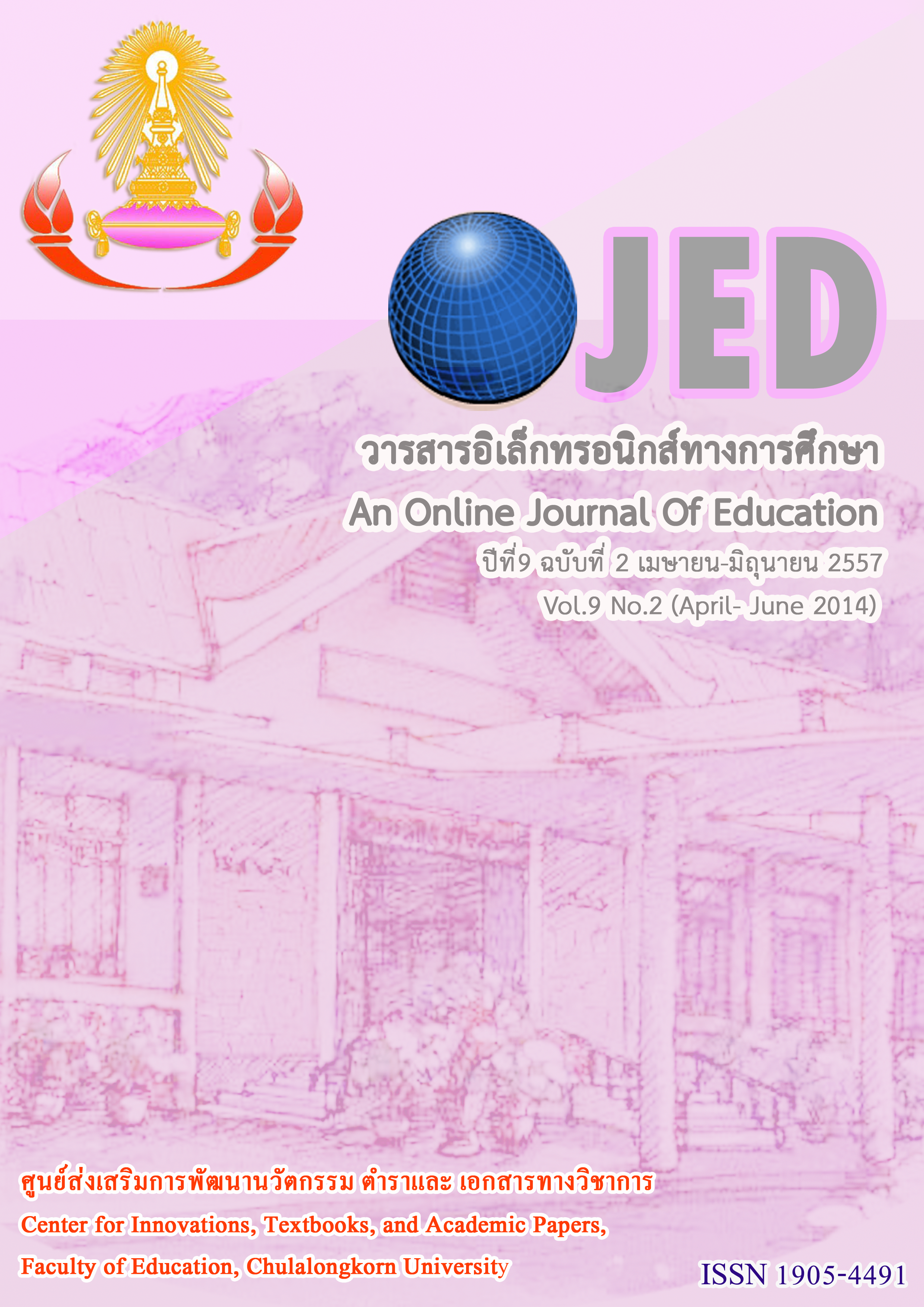การวิเคราะห์กลุ่มแฝงอัตลักษณ์เชิงวิชาชีพครู
Keywords:
อัตลักษณ์เชิงวิชาชีพครู, ครูไทย, การวิเคราะห์กลุ่มแฝง, Teachers’ Professional Identity, Thai teacher, Latent Class AnalysisAbstract
บทคัดย่อ
การวิจัยครั้งนี้มีวัตถุประสงค์เพื่อ 1) วิเคราะห์องค์ประกอบ และตัวบ่งชี้อัตลักษณ์เชิงวิชาชีพครูของครูไทย 2) วิเคราะห์กลุ่มแฝงอัตลักษณ์ เชิงวิชาชีพครูของครูไทย การวิจัยครั้งนี้เป็นการวิจัยแบบผสมวิธี แบบลำดับเวลา แบ่งเป็น 2 ระยะ ระยะที่ 1 เป็นการวิจัยเชิงคุณภาพ เพื่อตรวจสอบความเหมาะสมขององค์ประกอบและตัวบ่งชี้อัตลักษณ์เชิงวิชาชีพครูของครูไทยในเบื้องต้น ด้วยการสัมภาษณ์นักวิชาการทางการศึกษา 14 คน เครื่องมือที่ใช้ในการวิจัย คือ แบบสัมภาษณ์ วิเคราะห์ข้อมูลโดยใช้การวิเคราะห์เนื้อหา ระยะที่ 2 เป็นการวิจัยเชิงปริมาณ ตัวอย่างวิจัย คือ ครูสังกัดสำนักงานคณะกรรมการการศึกษาขั้นพื้นฐาน (สพฐ.) 625 คน เครื่องมือที่ใช้ในการวิจัย คือ 1) แบบสอบถาม โดยผ่านการตรวจสอบความตรงเชิงเนื้อหา มีค่าความสอดคล้องระหว่างข้อคำถามและวัตถุประสงค์อยู่ระหว่าง 0.57 ถึง 1.00 และมีค่าความเที่ยงอยู่ระหว่าง 0.601 ถึง 0.958 และ 2) แบบสอบวัดความรู้ในการประกอบวิชาชีพครู โดยผ่านการตรวจสอบความตรงเชิงเนื้อหา มีค่าความสอดคล้องระหว่างข้อคาถามและวัตถุประสงค์อยู่ระหว่าง 0.57 ถึง 1.00 มีค่าความยากอยู่ระหว่าง 0.211 ถึง 0.789 มีค่าอานาจจาแนกอยู่ระหว่าง 0.235 ถึง 0.824 และมีค่าความเที่ยงแบบ KR20 ท่ากับ 0.741 การวิเคราะห์ข้อมูล ประกอบด้วย การวิเคราะห์องค์ประกอบเชิงยืนยัน และการวิเคราะห์กลุ่มแฝง
ผลการวิจัยที่สาคัญสรุปได้ดังนี้ 1. อัตลักษณ์เชิงวิชาชีพครู ประกอบด้วย 3 องค์ประกอบ 26 ตัวบ่งชี้ ดังนี้ องค์ประกอบที่ 1 ความรู้ ในการประกอบวิชาชีพครู ประกอบด้วย 10 ตัวบ่งชี้ องค์ประกอบที่ 2 ความสามารถในการประกอบวิชาชีพครู ประกอบด้วย 9 ตัวบ่งชี้ และองค์ประกอบที่ 3 คุณธรรม จริยธรรม และจรรยาบรรณวิชาชีพ ประกอบด้วย 7 ตัวบ่งชี้ โมเดลอัตลักษณ์เชิงวิชาชีพครู ซึ่งประกอบด้วย 3 องค์ประกอบ และ 26 ตัวบ่งชี้ดังกล่าว มีความสอดคล้องกลมกลืนกับข้อมูลเชิงประจักษ์ (Chi-square = 183.745, df = 188, p = 0.574, GFI = 0.978, AGFI = 0.959 และ RMR = 0.019) 2. การวิเคราะห์ กลุ่มแฝงอัตลักษณ์เชิงวิชาชีพครูโดยภาพรวม พบว่าสามารถจำแนกครูได้เป็น 3 กลุ่ม ได้แก่ กลุ่มที่ 1 คือกลุ่มครูที่ไม่มีอัตลักษณ์เชิงวิชาชีพครู จำนวน 35 คน (ร้อยละ 5.60) กลุ่มที่ 2 คือ กลุ่มครูที่มีความรู้ และคุณธรรมประจำใจในการประกอบวิชาชีพครูต่ำ จำนวน 429 คน (ร้อยละ 68.64) และกลุ่มที่ 3 คือ กลุ่มครูที่มีความรู้ในการประกอบวิชาชีพครูต่า จำนวน 161 คน (ร้อยละ 25.76) จากจำนวนครูทั้งหมด 625 คน
คำสำคัญ: อัตลักษณ์เชิงวิชาชีพครู, ครูไทย, การวิเคราะห์กลุ่มแฝง
Abstract
The purposes of this study were 1) to analyze the components and indicators of the teachers’ professional identity of Thai teachers; 2) to analyze a latent class of the teachers’ professional identity of Thai teachers. This study employed an exploratory sequential mixed-methods research design. The study was divided into two phases. Phase 1 to validate factors and indicators of teacher’s professional identity of Thai teachers. By collecting data from 14 educational experts via interviews. The data were analyzed by content analysis. Phase 2 was the quantitative study collecting data from 625 teachers in OBEC schools. Research instruments included 1) questionnaires with Item-Objective Congruence (IOC) scores 0.57-1.00 and reliability coefficients of 0.601-0.958; and 2) teachers’ profession knowledge tests with IOC scores of 0.57-1.00, difficulty levels of 0.211-0.789, discrimination levels of 0.235-0.824, and the KR20 for reliability coefficient of 0.741. Analyze the data, including confirmatory factor analysis and latent class analysis.
Research results were as follows: 1. Teachers’ professional identity consisted of 3 factors covering 26 indicators: Factor 1-Knowledge of teacher’s profession measured by 10 indicators; Factor 2-Ability of teacher’s profession measured by 9 indicators; Factor 3-Morals of teacher’s profession measured by 7 indicators. The structural model of teachers’ professional identity fitted well with the empirical data (Chi-square = 183.745, df = 188, p = 0.574, GFI = 0.978, AGFI = 0.959 and RMR = 0.019) 2. The latent class analysis of teacher’s professional identity classified Thai teachers into three classes: Class 1 consisted of 35 teachers (5.60%) who were without teacher’s profession, Class 2 consisted of 29 teachers (68.64%) whose levels of knowledge and morals of teacher’s profession were low, and Class 3 consisted of 161 teachers (25.76%) whose level of knowledge of teacher’s profession was low.
KEYWORDS: Teachers’ Professional Identity, Thai teacher, Latent Class Analysis




